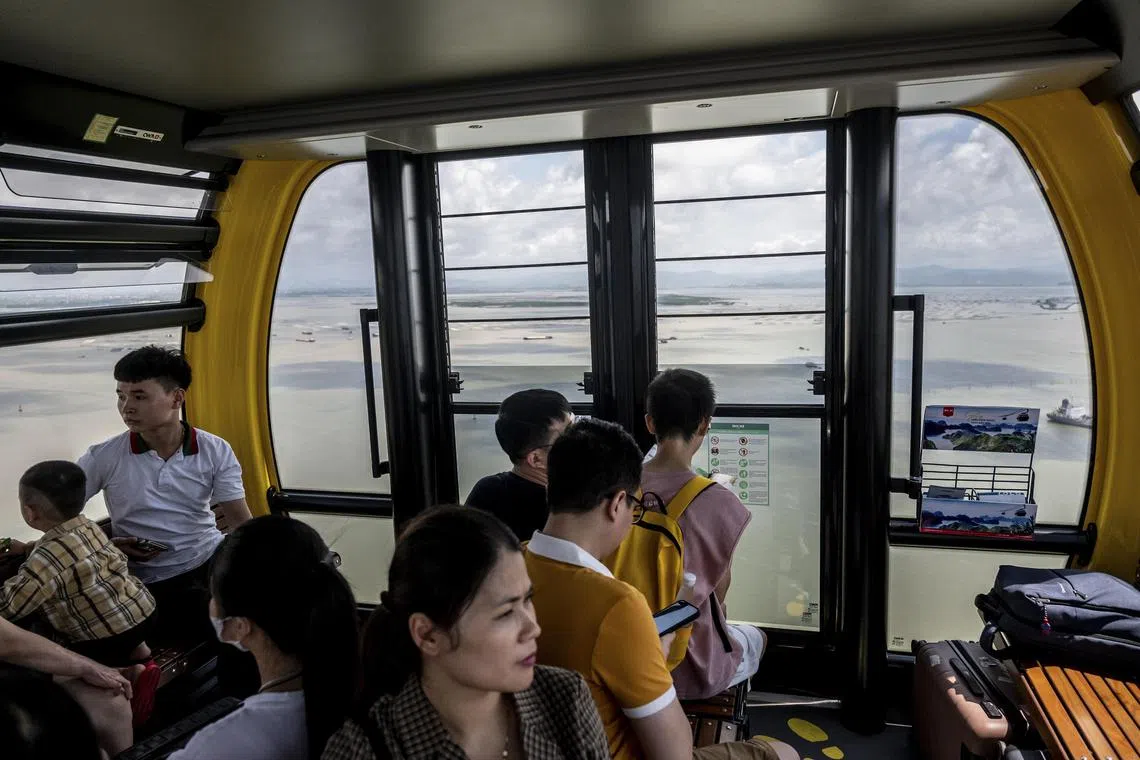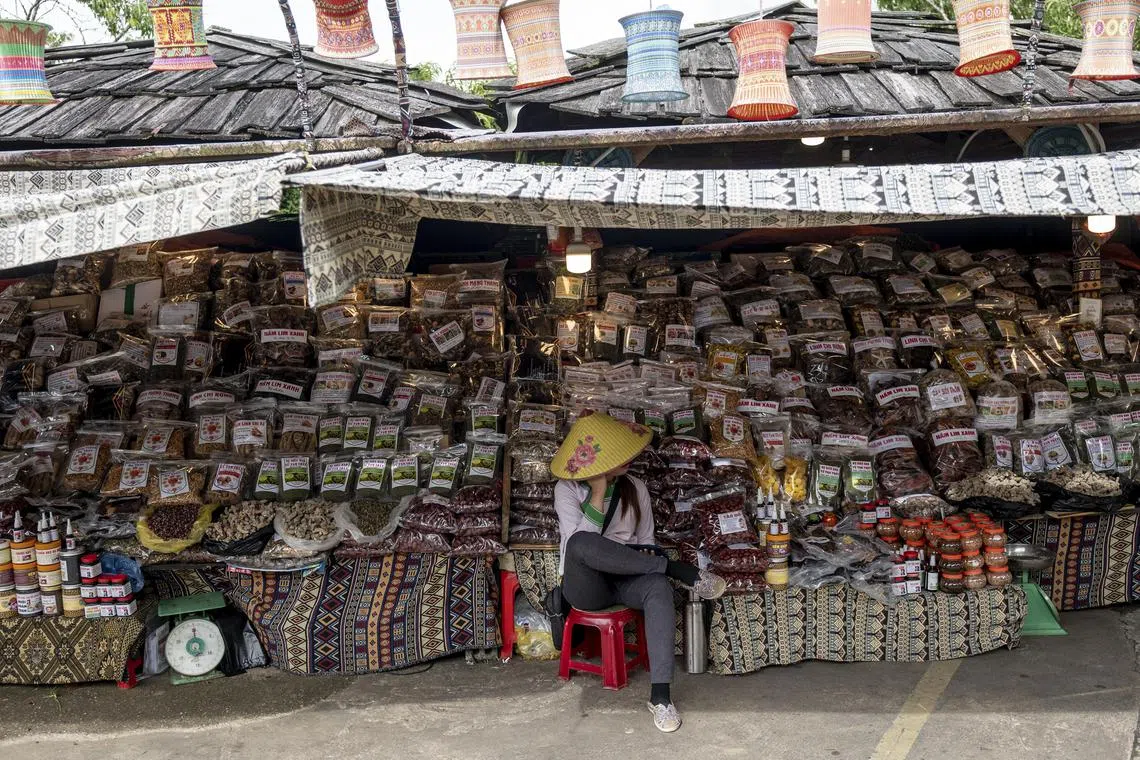If you can take the cable car to the ‘Colosseum’, you are in Vietnam
Sign up now: Get ST's newsletters delivered to your inbox

Posters in central Sapa, Vietnam, promoting the Fansipan Legend cable car line which holds a Guinness World Record.
PHOTO: NYTIMES
Patrick Scott
Follow topic:
VIETNAM – We are inside a glass box of a gondola, part of the longest passenger cable car in the world, flying silently along on a nearly 8km ride, and some 50 storeys above a sapphire sea just off the coast of Phu Quoc island in southern Vietnam.
Hundreds of colourful wooden fishing boats speckle the crystalline water below as we sail towards Hon Thom island.
On the way back, as the 20-minute ride nears an end, Phu Quoc station and the newly built town around it come into view.
The station looks like a full-scale, prefabricated section of the Roman Colosseum, and the town is an elaborate facsimile of a seaside Italian city complete with a hulking bell tower, mock Baroque fountains in piazzas and pseudo-Roman ruins.
Fanning out all around are several hundred pastel – and almost entirely empty – terraced buildings lining streets named Venice, Amalfi, Positano and Sorrento.
“It looks like Disneyland,” said Mr Tomek Tabaka, 44, part of a foursome of Polish friends travelling together.
“Or maybe The Truman Show,” he added, referring to the 1998 Jim Carrey film about simulated reality.
This two-part tourism colossus, called Sun World Hon Thom and Sunset Town, is one of Vietnam’s most astounding human-made attractions (or abominations, depending on your point of view).
That it is anchored by a cable car line is on trend for Vietnam, which is in the middle of a cable car bonanza. The nation is home to four of the longest cable car lines in the world, all built in the past decade, underscoring the stunning transformation of Vietnam’s economy and tourism sector.
Most of the growth in the global cable car industry is in the urban transit and tourism markets, and most of the action in the tourism sector is in Asia, said Mr Steven Dale, founder of the Gondola Project, an industry tracking website.
And in Asia, he said, one of the most prolific cable car developers is Vietnam. “On a per-capita basis, I would guess that Vietnam has more than any other Asian country,” added Mr Dale.
Some 26 cable car lines have been built in a dozen locations across Vietnam over the past two decades, according to data from cable car manufacturers.
Of course, hundreds of ski lifts have been built in Europe over the same period. But Vietnam is remarkable in its rapid escalation of the installations for tourism.
Most of Vietnam’s systems were built by the Doppelmayr Group of Austria – one of two consortia that dominate the industry, for the Sun Group of Vietnam – one of the country’s biggest real estate and tourism developers.
Sun Group’s founders made a fortune selling instant noodles in Ukraine before returning to Vietnam in 2007 to make a splash in tourism on Ba Na Hills in Danang, starting with an almost 6km cable car line to the top.
The company has added several more lines on Ba Na Hills, including the world’s longest single-cable ropeway last year.

A poster advertising the bridge at Sun World Ba Na Hills in Da Nang, at the ticket station of the Cat Hai–Phu Long cable car line in Hai Phong, Vietnam.
PHOTO: NYTIMES
Over time, it turned what had been a French hill station into Sun World Ba Na Hills, a European-style theme park with a faux French village and Gothic cathedral, underground amusement park, fairy-tale castles and a bridge seemingly held aloft by two giant hands that has become an online sensation.
Sun Group’s leaders insist on record-breaking cable cars with each project, as if on a patriotic mission to produce world-renowned tourism projects in Vietnam.
The company’s six Sun World attractions with cable cars boast nine Guinness World Records, including the longest three-cable ropeway at Phu Quoc (7.9km); biggest cable car cabin (230 passengers) on the Ha Long tramway; tallest cable car tower (215m), along the line to Cat Ba Island; and greatest vertical ascent (1,410m) to the top of Fansipan Mountain – Vietnam’s tallest peak, in the north in Sa Pa.

The Hotel de la Coupole, one of several luxury hotels famed architect and designer Bill Bensley has built for Sun Group, at the start of the Fansipan Legend cable car system in central Sa Pa, Vietnam.
PHOTO: NYTIMES
Low-carbon transport or over-development?
The cable cars can be seen as amazing feats of engineering that provide easy access to remote places, the height of transport entertainment and with a low-carbon footprint.
But they are typically parts of mass-tourism complexes, and some travellers, citizens and environmental activists see them as scars on the landscape and a symptom of rampant over-development by powerful conglomerates.
Environmentalists are anxious over Sun Group’s on-again, off-again plans for Cat Ba Island, neighbouring the famed Halong Bay in north-east Vietnam, including a network of cable cars, a resort, a golf course and a cruise ship port – all in an area designated by Unesco as a Biosphere Reserve.

Tourists in a Cat Hai-Phu Long cable car at the planned Sun World Cat Ba complex in Hai Phong.
PHOTO: NYTIMES
But in north-west Vietnam, near the summit of Fansipan Mountain, where Sun Group inaugurated a Buddhist-themed complex in 2018, Thai visitors Suvisa Vathananond and Patrick Tunhapong, both 44, considered the project a good balance between preservation and development.
They had ridden to the top in a gondola shrouded by thick clouds, before finally bursting into the clear near the summit.
There, the forested ranges perched on a shelf of cottony clouds, offering a view of the mountaintop complex modelled after 16th-century Vietnamese pagodas, including a network of stone staircases and a giant seated Buddha. No amusement rides, no hotels, no replicas of European landmarks.

The fog-shrouded summit of Fansipan Mountain, the highest peak in the Indo-Chinese Peninsula, where Sun Group inaugurated a Buddhist-themed complex in 2018.
PHOTO: NYTIMES
At the foot of the mountain in Sa Pa, the reviews were more mixed.
Sa Pa hosted a mere 65,000 tourists in 2010, before an expressway was built from Hanoi in 2014 and the cable car opened in 2016. By 2019, visitors had skyrocketed to 3.3 million, and hit 2.5 million last year in the post-pandemic rebound.
Ms Vu Han, who was visiting for her mother’s 60th birthday, likes how the cable car line makes the mountain more accessible, but is not a fan of the town’s unbridled growth.
“I see that their lives are getting better and that tourism is developing the province,” said the 26-year-old, who was working for a non-governmental healthcare and education organisation in Ho Chi Minh City. “But I still see too many buildings, too many huge hotels that are ruining the scenery. And I see a lot of kids going around asking for money.”

A view of central Sa Pa, which has expanded dramatically with development and traffic after the 2016 arrival of the Fansipan Legend cable car line.
PHOTO: NYTIMES
Sun Group’s chair, Mr Dang Minh Truong, in written responses to questions, highlighted the thousands of jobs created by Sun World properties and how the projects “help strengthen communities and contribute to the enrichment of society”.
He also noted the company’s desire to help Vietnamese access their country’s “endless natural wonders” and to “mark Vietnam as a ‘must-come destination’ on the global tourism map”.
Cheaper than roads
Vietnam’s topography, with its abundance of mountains, jungles and islands, is a natural fit for cable cars, which can be built faster, cheaper and with less environmental damage than roads, said Mr Dale, the cable car expert.
They also make sense for a developing country of about 100 million people with a rapidly growing middle class that may not easily afford a trip to Rome or Paris, but can manage a US$25 (S$33) to US$45 round-trip cable car ticket for a taste of ersatz Europe.

Vendors sell local food and souvenirs at the base of Sun World’s Fansipan Legend cable car line in Sa Pa.
PHOTO: NYTIMES
Ms Ly Tran, 34, who taught hospitality at a Ho Chi Minh City university before moving to Portugal to study for a doctorate in tourism, was with her Portuguese partner visiting Hon Thom – the small, private island owned by Sun Group where the Phu Quoc cable car line leads to a sprawling water park.
Vietnamese appreciate that tourism complexes like Sun World are well-organised and clean, she said. And cable cars make sense, she said, because Vietnamese tourists approach sightseeing differently from Westerners.
“When you see Westerners going sightseeing, they’re going to be in sports shoes and clothes,” she said. “But if you see Vietnamese, they are usually in a long dress and sandals or high heels. They want to be beautiful for the photo shoot.” NYTIMES

